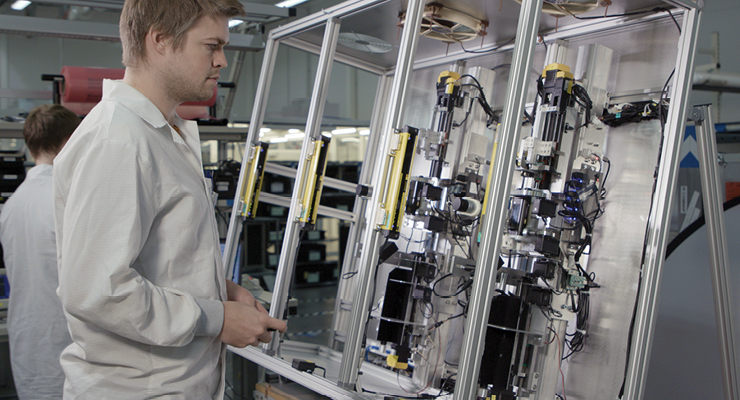Mark Crawford, Contributing Writer02.07.22
Business is booming in the electronic manufacturing services (EMS) segment of the medical device industry. According to MarketWatch, EMS in the medical/healthcare field is expected to grow at a compound annual growth rate of over 4 percent through 2026, thanks largely to greater use of automation and advanced technologies such as the Internet of Things (IoT), wireless, and artificial intelligence (AI).1
This business surge also reflects that EMS companies have evolved from providing pure manufacturing capabilities to offering end-to-end services that support the entire lifecycle of products for medical device manufacturers (MDMs). “This includes handling all aspects of production, including high-quality complex product assembly, manufacturing processes, and testing,” said Gary Switzer, senior vice president of medical systems for Sanmina Corporation, a San Jose, Calif.-based contract provider of EMS services. “Other services are assisting with regulatory certifications and collaborating on design prototyping, new product introduction, documentation management, and supplier management, as well as maintenance, repair, and end-of-life services.”
“Medical device manufacturers are tasked with speeding up innovation and adopting new and unfamiliar technologies, without cutting corners or jeopardizing quality,” added Christian Fritz, head of business development for maxon (Taunton, Mass), a provider of high-precision micro drives, motors, and other controls. “Increasingly, technology innovations such as miniaturization, high-performance computing, and data analytics have led to the development of highly complex electronic components for mission-critical tasks in medical applications.”
However, the speed of innovation and technology adoption is still hampered by the persistent supply chain challenges that continue to limit EMS manufacturing and product development. “Although the ongoing global COVID-19 pandemic has actually increased the demand for novel treatments, it has also caused serious disruptions that impact delivery schedules, cost, logistics, and production planning,” said Fritz.
The pandemic continues to severely test the supply chain. All manufacturers are struggling with logistics costs and material lead times (wait times for some raw printed circuit boards, resistors, capacitors, and semiconductors have taken 52 weeks or longer, in some cases). Some EMS providers have resorted to the re-engineering or reverse engineering of product designs so they can work with materials and components that are readily available. It has never been more important for MDMs and their supply chain partners to collaborate creatively to minimize disruptions and shortages.
“This is a time when our people, systems, and processes are being severely tested,” said John Sammut, CEO of Grand Rapids, Mich.-based Firstronic, which provides advanced electronics manufacturing services, and optimized supply chain solutions and is part of LACROIX’s global network of EMS facilities. “Fortunately, Firstronic has been able to extend forecasting out two years and get the products we need via our global network and supply chain relationships to keep deliveries on time.”
This article is featured in the MPO eBook "Engaging Electronics." Click here to download the eBook and finish reading this article.
This business surge also reflects that EMS companies have evolved from providing pure manufacturing capabilities to offering end-to-end services that support the entire lifecycle of products for medical device manufacturers (MDMs). “This includes handling all aspects of production, including high-quality complex product assembly, manufacturing processes, and testing,” said Gary Switzer, senior vice president of medical systems for Sanmina Corporation, a San Jose, Calif.-based contract provider of EMS services. “Other services are assisting with regulatory certifications and collaborating on design prototyping, new product introduction, documentation management, and supplier management, as well as maintenance, repair, and end-of-life services.”
“Medical device manufacturers are tasked with speeding up innovation and adopting new and unfamiliar technologies, without cutting corners or jeopardizing quality,” added Christian Fritz, head of business development for maxon (Taunton, Mass), a provider of high-precision micro drives, motors, and other controls. “Increasingly, technology innovations such as miniaturization, high-performance computing, and data analytics have led to the development of highly complex electronic components for mission-critical tasks in medical applications.”
However, the speed of innovation and technology adoption is still hampered by the persistent supply chain challenges that continue to limit EMS manufacturing and product development. “Although the ongoing global COVID-19 pandemic has actually increased the demand for novel treatments, it has also caused serious disruptions that impact delivery schedules, cost, logistics, and production planning,” said Fritz.
The pandemic continues to severely test the supply chain. All manufacturers are struggling with logistics costs and material lead times (wait times for some raw printed circuit boards, resistors, capacitors, and semiconductors have taken 52 weeks or longer, in some cases). Some EMS providers have resorted to the re-engineering or reverse engineering of product designs so they can work with materials and components that are readily available. It has never been more important for MDMs and their supply chain partners to collaborate creatively to minimize disruptions and shortages.
“This is a time when our people, systems, and processes are being severely tested,” said John Sammut, CEO of Grand Rapids, Mich.-based Firstronic, which provides advanced electronics manufacturing services, and optimized supply chain solutions and is part of LACROIX’s global network of EMS facilities. “Fortunately, Firstronic has been able to extend forecasting out two years and get the products we need via our global network and supply chain relationships to keep deliveries on time.”
This article is featured in the MPO eBook "Engaging Electronics." Click here to download the eBook and finish reading this article.















